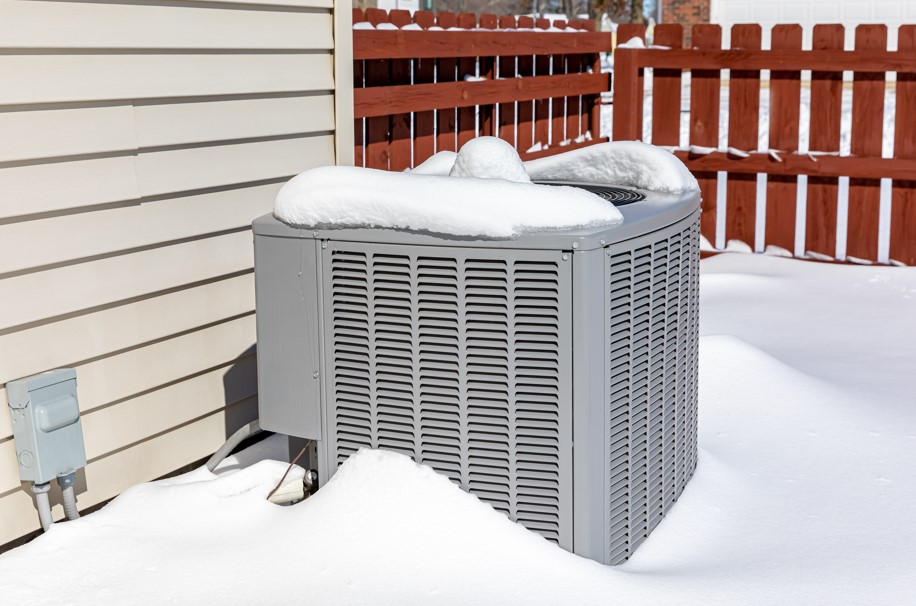Should I Cover My Air Conditioner in the Winter?

This is a question we’ve heard often, and the answer is a bit complex. The fact is, your air conditioner unit is designed to withstand years of punishment from the elements. Even the components inside the unit are designed to withstand harsh environments.
So should you cover your AC in winter?
Yes and no. Covering your AC unit in winter doesn’t protect it against freezing temperatures. In fact, it can actually cause more damage than good. A major issue with covering your AC unit in winter is that you’re blocking airflow from circulating through the vents.
This can cause moisture to build up, which can lead to mold and mildew growth. What you need to do is let your AC unit breathe. If you don’t get a lot of snow and ice in your area, the ideal thing to do is to keep the vents free of debris. Make sure they’re not blocked by snow or ice by removing any build-up.
This can help reduce the risk of mold and mildew growth, as well as make sure your AC unit is running efficiently. If you just can’t stand to see those vents covered with ice, consider using a dehumidifier or a fan with an air filter to keep moisture levels in check.
When Should I Cover My Air Conditioner?
If you live in an area that gets a lot of icing and snow during the winter months, you may want to consider covering your AC unit. This will help:
- Keep it from getting covered in snow that can weigh down the unit, causing damage. The cover will also protect the air conditioner from ice build-up, which is common when temperatures drop below 32 degrees Fahrenheit or 0 degrees Celsius.
- Protect it from falling icicles that can damage or puncture your air conditioner.
- Keep it from getting dirty. This will make it easier for you to maintain the unit when you take it off in the spring, which can help prolong its lifespan.
- Protect it from falling leaves and other debris, which can clog vents and restrict airflow.
Pay attention to how the cover works with your air conditioner. Make sure you can take the cover off and put it on easily and that it doesn’t interfere with the operation of your unit.
What Type of Cover Can I Use?
Before we get to what type of cover to use, you should know that a good cover should;
- Protect your AC unit from damage caused by falling leaves and other debris, which can clog up your unit and cause it to malfunction.
- Offer protection against snow and ice buildup, which can bend fins and damage the compressor.
- Protect your unit from animals such as birds and squirrels that may want to build a nest on or inside it.
- Should help reduce drafts and keep the unit clean, so it’s ready for use in Spring
- Should be made from durable materials which can withstand the elements but also be light enough that you don’t have to struggle when moving it around.
- Should be easy to install so that you don’t have to spend too much time and effort trying to put it together.
- Should not have any sharp or pointy edges or other objects that can damage your AC unit.
- Should be reasonably priced so that it doesn’t cost a fortune just to protect your air conditioner.
That said, you don’t have to buy an expensive cover for your AC. You can simply cover it with a piece of plywood and use rocks or bricks to weigh it down.
You can also choose to build a small shed to protect your AC. All you need is a little bit of space and some basic carpentry skills. However, if you’re not up to it, you could get a prefab shed that can be installed by a professional. This would be the easiest way to install an AC shelter, and it will save you time and effort.
The good thing about installing a shed for your AC is that you can choose the size and design you want. You can also choose a shed that will match your home’s architectural style.
Keep in mind that it’s always a good idea to consult the manual provided by the manufacturer before covering your AC, as some of them may have specific instructions or recommendations on how to cover the unit. And some models are not designed to be covered.
What Type of Cover Should I Not Use?
You should not use covers that are not specifically designed for air conditioners. Using a cover that is not designed for an AC unit can lead to moisture buildup, which can lead to mold and mildew growth. So avoid waterproof covers like tarps and those made from plastic since they can trap moisture and cause mold and mildew issues.
If you’re not sure what type of cover to use for your AC, give us a call. We can advise you on which ones you should avoid and help you figure out the best type for your needs.
How To Prepare Your AC for Winter
Before you cover your air conditioner, make sure that you unplug or turn off the power. If you can, remove your filter and clean it thoroughly.
You should also check the unit for dirt and debris and remove any that you find. Also, check for leaks by checking all connections and looking for damp spots on the floor.
You should also check inside your unit for any signs of mold or mildew and remove it if you find any. Once you’re satisfied with your AC’s condition, you can go ahead and cover it.
Final Thoughts
In the end, it’s up to you to decide if a cover is right for your air conditioner. If you live in an area that gets freezing temperatures and snow, covering your unit may be an effective way to protect it from damage.
However, be sure to leave enough room for air circulation at all times. Covers that allow for good airflow can reduce problems such as condensation buildup and moisture collection inside your unit.
You may need to make a few modifications if you don’t want to buy one that’s specifically made for an outdoor central system. Look for covers made of breathable materials rather than plastic sheets or tarp material.
